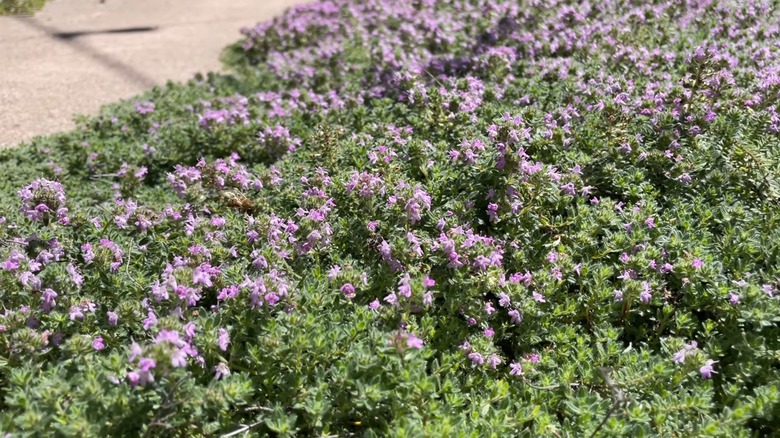The No-Mow Grass Alternative That's Unique And Unconventional
Grass has long been the default ground cover for American yards, but the cult of the lawn is losing steam. Water restrictions, rising maintenance costs, and a new generation of eco-conscious homeowners are fueling a no-mow renaissance. While clover and moss still get most of the spotlight, the most imaginative alternatives go beyond just removing the mower. They rewrite what a yard can be.
Case in point: the herb garden. Not the raised-bed kitchen kind, but a soft, fragrant carpet of creeping thyme, chamomile, and other low-growing varieties that feel like a European courtyard underfoot. This living ground cover offers all the aesthetic payoffs of traditional turf with none of the noise or guilt. Bonus: it multitasks. Herbs like thyme and chamomile are culinary staples, pest deterrents, and pollinator magnets. If you want to level it up, consider designing a spiral-shaped herb garden using landscaping rocks. It's a clever layout that maximizes both airflow and charm.
What makes this no-mow option especially appealing is that it doesn't just look good on Instagram. It works. Thyme tolerates foot traffic and thrives in full sun; chamomile adds fragrance and a soft bloom come spring. The best type of soil for growing herbs is a well-draining one, which also reduces the need for irrigation or chemical upkeep.
How to turn your lawn into a living herbscape
A no-mow herb lawn can be a win-win-win: less labor for you, more sustainability for the planet, and a better-smelling yard. First, you'll want to choose your herbs wisely. Creeping thyme (Thymus praecox) remains the go-to for its durability and low height, but it's not the only contender. Chamomile (Chamaemelum nobile) adds a sweet bloom and gentle fragrance. The beautiful and equally fragrant Corsican mint (Mentha requienii) ground cover is also well worth the effort. Oregano (Origanum) and even low-growing varieties of marjoram (Origanum majorana) and savory (Satureja montana) can handle light foot traffic and act as hardy ground covers. Just avoid culinary mint (Mentha spp.) as it spreads aggressively and can quickly turn a tidy yard into a wild botanical takeover.
You'll also want to sidestep herbs that are too delicate or upright. Stick with species that hug the soil and bounce back after being stepped on. And don't expect year-round lushness in cold climates. Many herbs die back in winter or go dormant, leaving behind a patchier look until spring. That said, most will return once temps rise, especially if you use hardy perennials suited to your USDA zone.
Next, for the setup, you've got options. You can sow from seed (slower and a bit more finicky) or jump-start with seedlings or plugs, which fill in faster. Some homeowners choose to remove existing turf before planting, but others opt to overseed directly into thinning grass for a hybrid approach. Just make sure your lawn has full sun and good drainage, and amend the soil with compost if needed. Once established, watering is minimal.

